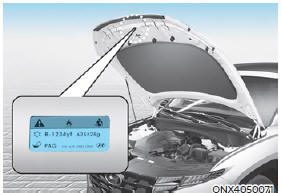Hyundai Tucson: System operation
Ventilation
- Set the mode to the
 position.
position. - Set the air intake control to the outside (fresh) air position.
- Set the temperature control to the desired position.
- Set the fan speed control to the desired speed.
Heating
- Set the mode to the
 position.
position. - Set the air intake control to the outside (fresh) air position.
- Set the temperature control to the desired position.
- Set the fan speed control to the desired speed.
- If desired, turn the air conditioning ON with the temperature control knob set to heat in order to dehumidify the air before it enters into the cabin.
If the windshield fogs up, set the mode
to the  or
or
 position.
position.
Operation Tips
- To help keep dust or unpleasant fumes from entering the vehicle through the ventilation system, temporarily set the air intake control to the recirculated air position. Be sure to return the control to the fresh air position when the irritation has passed to keep fresh air in the vehicle. This will help keep the driver alert and comfortable.
- To prevent interior fog on the windshield, set the air intake control to the fresh air position and fan speed to the desired position, turn on the air conditioning system, and adjust the temperature control to the desired temperature.
Air conditioning
HYUNDAI Air Conditioning Systems are filled with R-1234yf refrigerant.
- Start the engine. Push the air conditioning button.
- Set the mode to the
 position.
position. - Set the air intake control to the outside air or recirculated air position.
- Adjust the fan speed control and temperature control to maintain maximum comfort.
Information
Your HYUNDAI vehicle is filled with R-1234-yf refrigerant. Information regarding the refrigerant designation for your vehicle can be found on the information label located under the hood.
Refer to chapter 8 for the location of the air conditioning refrigerant label.

NOTICE
- The refrigerant system should only be serviced by trained and certified technicians to insure proper and safe operation.
- The refrigerant system should be serviced in a well-ventilated place.
- The air conditioning evaporator (cooling coil) shall never be repaired or replaced with one removed from a used or salvaged vehicle and new replacement MAC evaporators shall be certified (and labeled) as meeting SAE Standard J2842.
NOTICE
- When using the air conditioning
system, monitor the temperature
gauge closely while driving up
hills or in heavy traffic when
outside temperatures are high.
Air conditioning system operation may cause engine overheating.
Continue to use the fan but turn the air conditioning system off if the temperature gauge indicates engine overheating.
- When opening the windows in humid
weather air conditioning may create
water droplets inside the vehicle.
Since excessive water droplets may cause damage to electrical equipment, air conditioning should only be used with the windows closed.
Air conditioning system operation tips
- If the vehicle has been parked in direct sunlight during hot weather, open the windows for a short time to let the hot air inside the vehicle escape.
- After sufficient cooling has been achieved, switch back from the recirculated air to the fresh outside air position.
- To help reduce moisture inside of the windows on rainy or humid days, decrease the humidity inside the vehicle by operating the air conditioning system with the windows and sunroof closed.
- Use the air conditioning system every month for a few minutes to ensure maximum system performance.
- If you operate the air conditioner
excessively, the difference between
the temperature of the outside air and
that of the windshield could cause
the outer surface of the windshield to
fog up, causing loss of visibility. In this
case, set the mode selection knob to
the
 position and set the fan
speed
control knob to the lowest speed
setting.
position and set the fan
speed
control knob to the lowest speed
setting.
READ NEXT:
 System maintenance
System maintenance
Cabin air filter
[A] : Outside air, [B] : Recirculated air
[C] : Cabin air filter, [D] : Blower
[E] : Evaporator core, [F] : Heater core
The cabin air filter is installed behind
the glove box. It filters the dust or other
pollutants that en
 Automatic heating and air conditioning
Automatic heating and air conditioning
Driver's temperature control button/
knob
Passenger's temperature control
button/knob
AUTO (automatic control) button
Air intake control button
OFF button
Front windshield defroster button
A/C (air conditioning) button
Fan sp
SEE MORE:
 Concentric Slave Cylinder Assembly- Installation
Concentric Slave Cylinder Assembly- Installation
Manual Transaxle Type
To install, reverse the removal procedures.
WARNING
Install the concentric slave cylinder bolts. Not to be bent or
twisted, Tighten them in diagonal directions.
Cup. Inner surface of body and outer surface of tub
 Camshaft - Installation
Camshaft - Installation
Install the intake CVVT (A).
Install the CVVD assembly (A).
WARNING
After installing the CVVD, check whether the swing arm is
separated or is installed correctly.
When installing the intake camshaft, spray the engine oil
Information
- Home
- Hyundai Tucson - Fourth generation (NX4) - (2020-2023) - Owner's Manual
- Hyundai Tucson - Fourth generation (NX4) - (2020-2023) - Workshop Manual